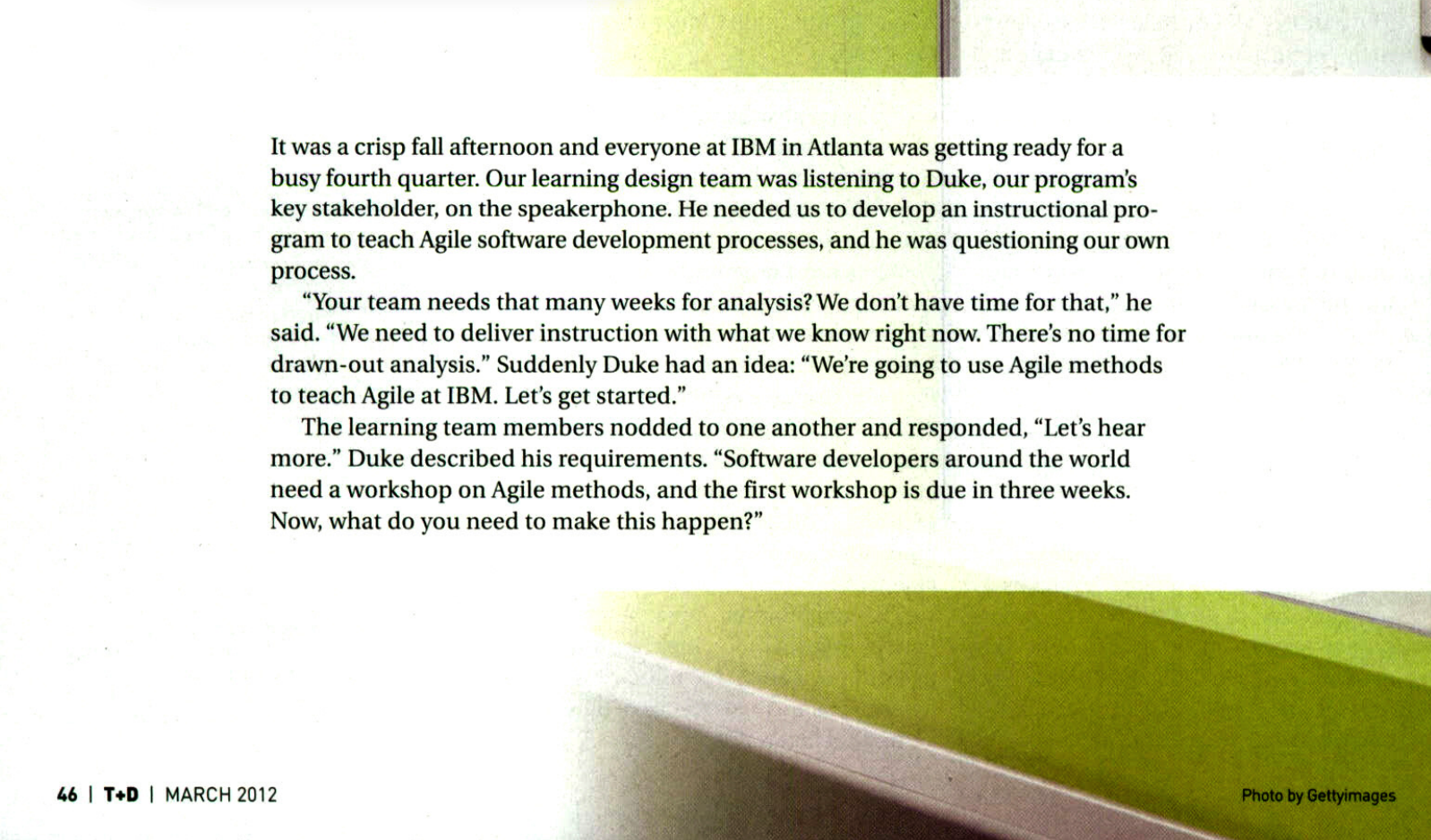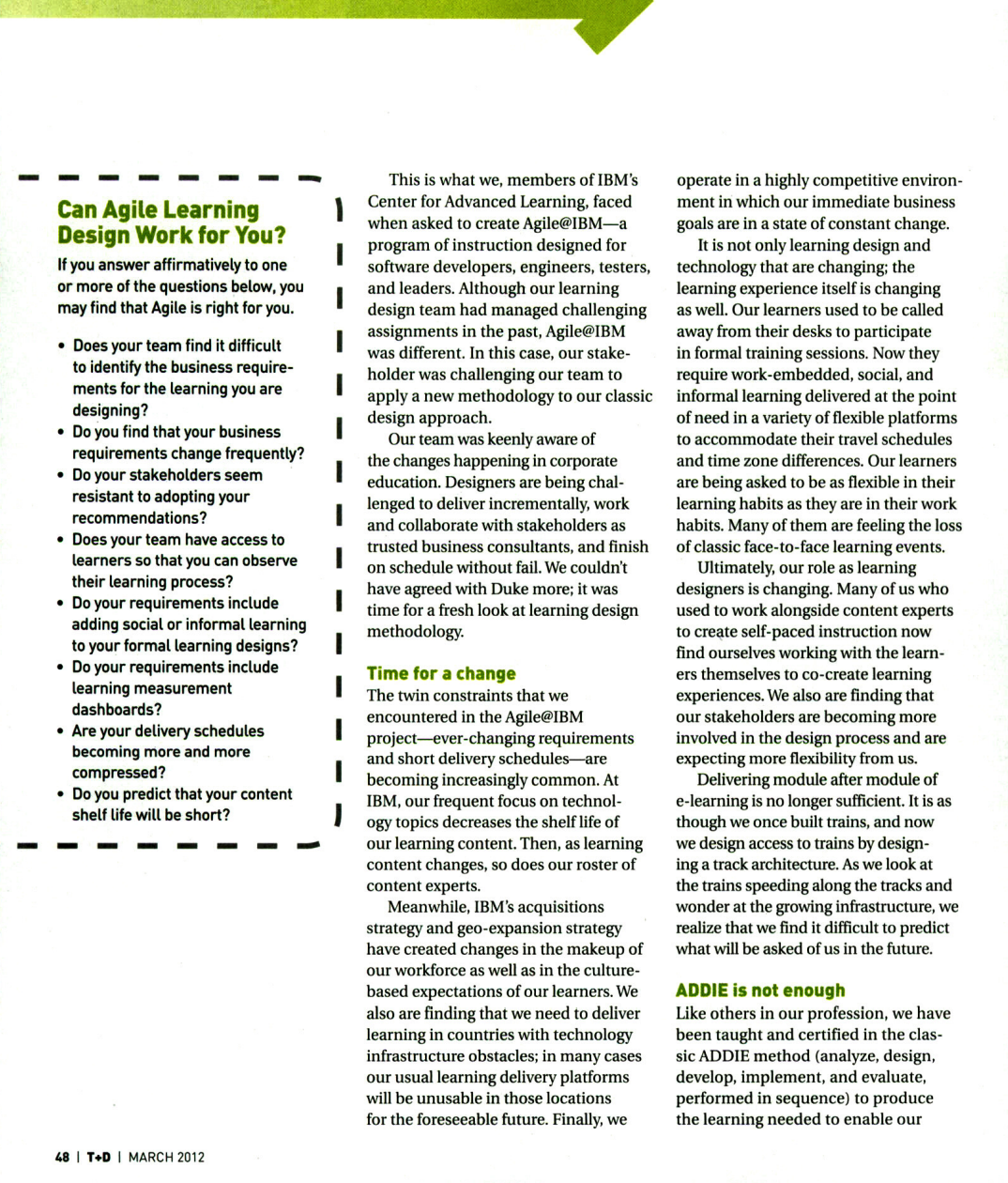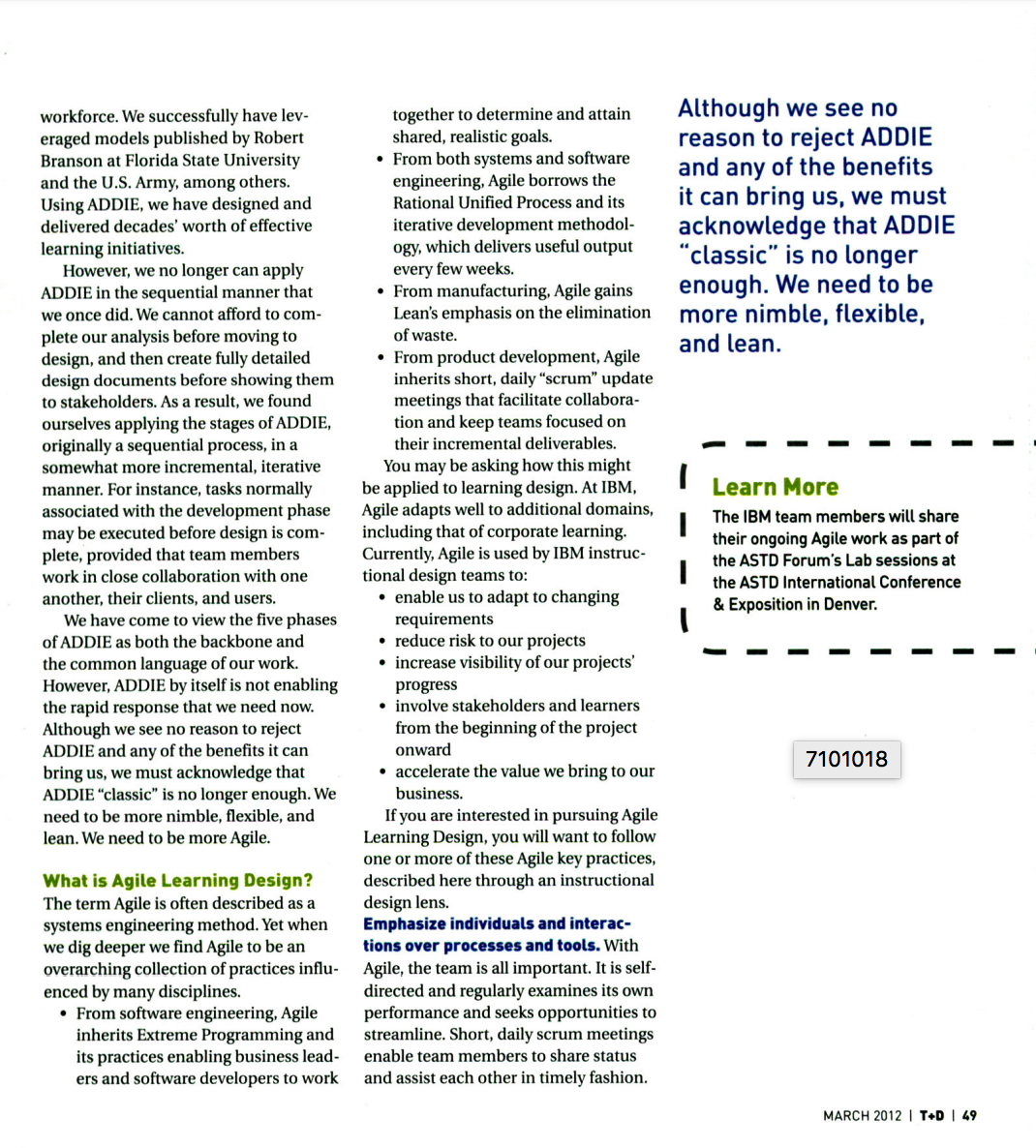How is the role of learning designers changing?
What is agile learning design?
What are its implications for instructional design?
just need to understand these questions according to the reading
Thank you so much
it was a crisp fall afternoon and everyone at IBM in Atlanta was getting ready for a busy fourth quarter. Our learning design team was listening to Duke. our program's key stakeholder, on the speakerphone. He needed us to develop an instructional pro- gram to teach Agile software development processes, and he was questioning our own process. \"Your team needs that many weeks for analysis? We don't have time for that." he said. \"We need to deliver instruction with what we know right now. There's no time for drawn-out analysis.\" Suddenly Duke had an idea: \"We're going to use Agile methods to teach Agile at IBM. Let's get started.\" The learning team members nodded to one another and responded, \"Let's hear more.\" Duke described his requirements. \"Software developers around the world need a workshop on Agile methods. and the rst workshop is due in three weeks. Now. what do you need to make this happen?\" '6 | Til-II I MARCH 2012 This is what we, members of IBM's operate in a highly competitive environ- Can Agile Learning Center for Advanced Learning, faced ment in which our immediate business Design Work for You? when asked to create Agile@IBM-a goals are in a state of constant change. program of instruction designed for It is not only learning design and If you answer affirmatively to one software developers, engineers, testers, technology that are changing; the or more of the questions below, you and leaders. Although our learning learning experience itself is changing may find that Agile is right for you. design team had managed challenging as well. Our learners used to be called Does your team find it difficult assignments in the past, Agile@IBM away from their desks to participate to identify the business require- was different. In this case, our stake- in formal training sessions. Now they ments for the learning you are holder was challenging our team to require work-embedded, social, and designing? apply a new methodology to our classic informal learning delivered at the point Do you find that your business design approach. of need in a variety of flexible platforms requirements change frequently? Our team was keenly aware of to accommodate their travel schedules . Do your stakeholders seem the changes happening in corporate and time zone differences. Our learners resistant to adopting your education. Designers are being chal- are being asked to be as flexible in their recommendations? lenged to deliver incrementally, work learning habits as they are in their work . Does your team have access to and collaborate with stakeholders as habits. Many of them are feeling the loss learners so that you can observe trusted business consultants, and finish of classic face-to-face learning events. their learning process? on schedule without fail. We couldn't Ultimately, our role as learning . Do your requirements include have agreed with Duke more; it was designers is changing. Many of us who adding social or informal learning time for a fresh look at learning design used to work alongside content experts to your formal learning designs? methodology. to create self-paced instruction now . Do your requirements include find ourselves working with the learn- learning measurement Time for a change ers themselves to co-create learning dashboards? The twin constraints that we experiences. We also are finding that . Are your delivery schedules encountered in the Agile@IBM our stakeholders are becoming more becoming more and more project-ever-changing requirements involved in the design process and are compressed? and short delivery schedules-are expecting more flexibility from us. . Do you predict that your content becoming increasingly common. At Delivering module after module of shelf life will be short? IBM, our frequent focus on technol- e-learning is no longer sufficient. It is as ogy topics decreases the shelf life of though we once built trains, and now our learning content. Then, as learning we design access to trains by design- content changes, so does our roster of ing a track architecture. As we look at content experts. the trains speeding along the tracks and Meanwhile, IBM's acquisitions wonder at the growing infrastructure, we strategy and geo-expansion strategy realize that we find it difficult to predict have created changes in the makeup of what will be asked of us in the future. our workforce as well as in the culture- based expectations of our learners. We ADDIE is not enough also are finding that we need to deliver Like others in our profession, we have learning in countries with technology been taught and certified in the clas- infrastructure obstacles; in many cases sic ADDIE method (analyze, design, our usual learning delivery platforms develop, implement, and evaluate, will be unusable in those locations performed in sequence) to produce for the foreseeable future. Finally, we the learning needed to enable our 48 | T+D | MARCH 2012workforce. We successfully have lev- eraged models published by Robert Branson at Florida State University and the U.S. Army. among others. Using ADDIE. we have designed and delivered decades' worth of effective learning initiatives. However. we no longer can apply ADDiE in the sequential manner that we once did. We cannot afford to com- plete our analysis before moving to design. and then create fully detailed design documents before showing them to stakeholders. As a result. we found ourselves applying the stages of ADDlE. originally a sequential process. in a somewhat more incremental. iterative manner. For instance. tasks normally associated with the development phase maybe executed before design is com- plete. provided that team members work in close collaboration with one another, their clients. and users. We have come to View the five phases of ADDIE as both the backbone and the common language of our work. However. ADDlE by itself is not enabling the rapid response that we need now. Although we see no reason to reject ADDIE' and any of the benets it can bring us. we must acknowledge that ADDIE \"classic" is no longer enough. We need to be more nimble. exible. and lean.We need to be more Agile. What is Agile Learning Design? The term Agile is often described as a systems engineering method. Yet when wedigdeeperwendAgiletobean overarchng collection of practices influ- enced by many disciplines. c From software engineering. Agile inherits Extreme Programming and its practices enabling business lead- ers and software developers to work together to determine and attain shared. realistic goals. - From both systems and software engineering, Agile borrows the Rational Unied Process and its iterative development methodol- ogy, which delivers useful output every few weeks. - From manufacturing. Agile gains Leah's emphasis on the elimination of waste. . From product development, Agile inherits short. daily \"scrum" update meetings that facilitate collabora- tion and keep teams focused on their incremental deliverables. You may be asking how this might be applied to learning design. At IBM. Agile adapts well to additional domains. including that of colporate learning. Currently, Agile is used by IBM instruc- tional design teams to: r enable us to adapt to changing requirements - reduce risk to our projects - increase visibility of our projects' progress - involve stakeholders and learners from the beginning of the project onward 0 accelerate the value we bring to our business. If you are interested in pursuing Agile teaming Design. you will want to follow one or more of these Agile key practices. described here through an instructional design lens Emphasize individuals and interac- tions our arms and tools. With Agile. the team is all important. It is self- directed and regularly examines its own performance and seeks opportunities to streamline. Short. daily scrum meetings enable team members to share status and assist each other in timely fashion. Although we see no reason to reject AD DIE and any of the benefits it can bring us. we must acknowledge that ADDIE \"classic" is no longer enough. We need to be more nimble. flexible. and lean. Learn More The IBM team members will share their ongoing Agile work as part oi the ASTD Forum's Lab sessions at the ASTD International Conference & Exposition in Denver. 7101018 MARCH 2012 I 1'10 I H









